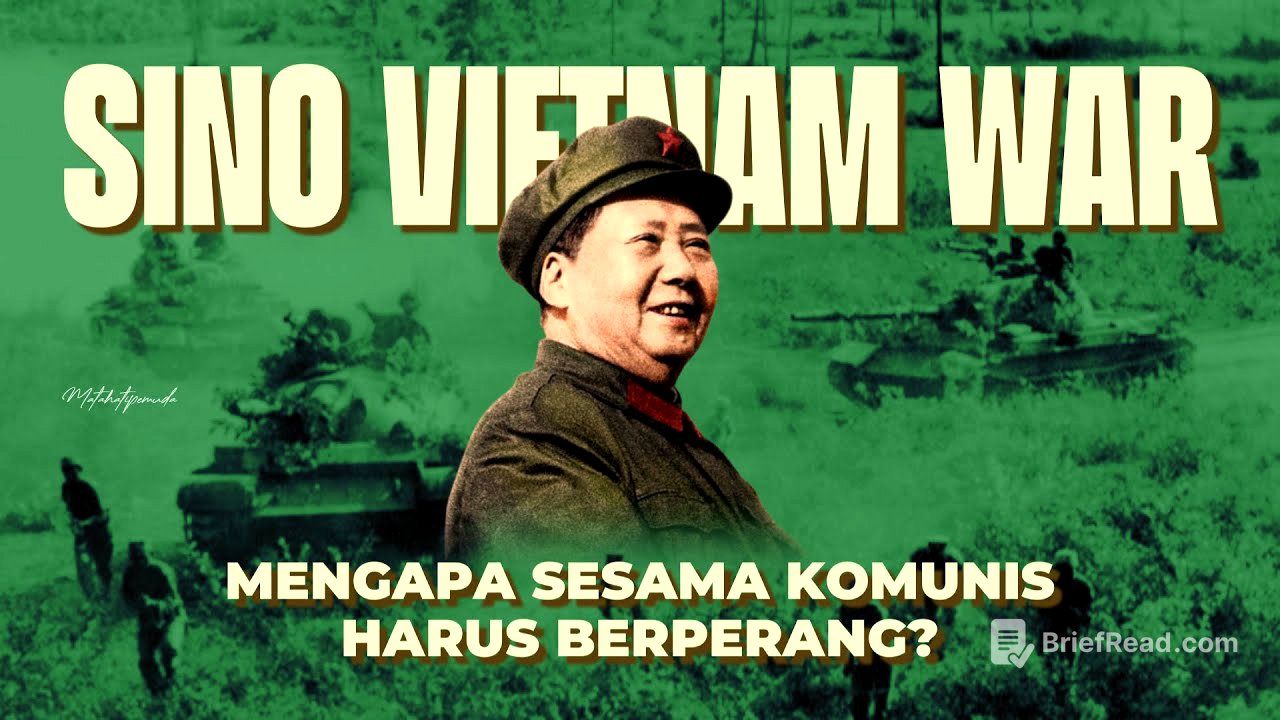TLDR;
This video explores the complex conflicts involving Vietnam, Cambodia, and China after the Vietnam War. It details Vietnam's invasion of Cambodia to overthrow Pol Pot's regime, China's subsequent invasion of Vietnam as a "punishment," and the underlying tensions between communist states. The video also touches on the historical context of Sino-Soviet relations and the long-term impacts of these conflicts on Vietnam's economy and regional relations.
- Vietnam's invasion of Cambodia (1978) to remove Pol Pot's regime.
- China's invasion of Vietnam (1979) as a response to Vietnam's actions in Cambodia and broader geopolitical tensions.
- The complex relationships between communist states (Soviet Union, China, Vietnam, Cambodia) and their ideological and territorial disputes.
Introduction [0:02]
The video introduces the post-Vietnam War era, highlighting that despite expelling America and unifying the country, Vietnam continued to face conflicts and wars. It sets the stage for discussing the hostilities between Vietnam, Cambodia, and China, despite their shared communist ideologies. The intro mentions Vietnam's invasion of Cambodia in 1978 and China's subsequent attack on Vietnam in 1979, questioning the reasons behind these conflicts among communist allies and who was to blame.
Vietnam and Cambodia's Relationship [3:24]
Initially, Vietnam and Cambodia had a positive relationship, especially during the Indochina War, with Cambodia allowing North Vietnam to use its territory to attack the South. However, this changed in 1970 when Lonol, backed by America, overthrew Prince Norodom Shihano and issued an ultimatum for North Vietnamese troops to leave Cambodia. Instead of leaving, North Vietnam supported the Cambodian communist group, the Red Hammer (Khmer Rouge), with funds and military aid to fight against Lonol's pro-American government.
Rise of Pol Pot and Conflict with Vietnam [5:54]
With Hanoi's support, the Red Hammer, led by Pol Pot, gradually gained power, overthrowing Lonol's regime in 1975 and establishing the government of Kampuchea. Pol Pot, an authoritarian leader, implemented radical social engineering policies based on Chinese Maoism, leading to the deaths of approximately 2 million Cambodians. Fearing Vietnamese expansionism, Pol Pot initiated purges of Vietnamese-related individuals and loyalists of the previous leader, Lonol. In May 1975, Cambodia invaded Vietnamese islands, leading to initial skirmishes and escalating tensions between the two nations.
Escalation of Hostilities [9:12]
Despite diplomatic exchanges in 1976, Cambodia remained wary of Vietnamese expansionism and made preemptive moves. In March 1977, the Kampuchean revolutionary army attacked Vietnamese provinces, resulting in civilian casualties. Further attacks in September 1977 prompted Vietnam to gather troops for a counterattack in December 1977. The Pol Pot regime severed diplomatic relations with Vietnam and rejected peace negotiations mediated by China. Continued attacks by Cambodia led to the deaths of thousands of Vietnamese civilians, prompting Vietnam to prepare for a major retaliation.
Vietnam's Invasion of Cambodia [13:58]
Vietnam, believing China was supporting Cambodia, decided to crush Cambodia and overthrow the Red Hammer government. On December 2, 1978, the pro-Vietnam FUNSK group, led by Heng Samamrin, was formed in Krati province. On December 21, 1978, Vietnam launched a full-scale invasion with 150,000 soldiers, employing the "Lotus Bloom" strategy to quickly control key areas and strategic shelters. By early January 1979, Vietnam controlled all of Cambodia, leading to the establishment of the People's Republic of Kampuchea, sponsored by Vietnam, with Heng Samamrin as the new leader.
China's Invasion of Vietnam [19:15]
Ten days after Vietnam's success in Cambodia, China invaded Vietnam. The video explains the rift between China and the Soviet Union, noting that Vietnam was backed by the Soviets. After Stalin's death, Khrushchev's policies opposed Mao Zedong, leading to ideological clashes and competition for influence. China felt betrayed by Vietnam's alignment with the Soviet Union and its opposition to the Cambodian Pol Pot regime.
Sino-Vietnamese Relations [25:18]
Initially, China played a significant role in supporting North Vietnam during the Indochina War, providing substantial financial assistance. However, tensions rose due to disagreements over guerrilla strategies and China's rejection of Soviet aid access through its territory. The relationship further deteriorated when American President Nixon visited China, leading North Vietnam to feel betrayed. Territorial disputes and Vietnam's invasion of Cambodia exacerbated tensions, leading China to view Vietnam as a threat to its regional influence.
The Sino-Vietnamese War [31:25]
Before the invasion, Deng Xiaoping aimed to limit the scope of attacks to achieve China's political goals and avoid deeper conflict. On February 17, 1979, China launched its invasion with 330,000 troops, focusing on key provinces along the Vietnamese border. The PLA implemented a "scorched earth" strategy, destroying infrastructure and plundering resources. Vietnam mobilized troops to defend against the Chinese advance, resulting in fierce battles.
Aftermath and Long-Term Impacts [35:53]
On March 6, 1979, China declared victory and began withdrawing its troops by March 16, 1979. Both Vietnam and China claimed victory, but China failed to force Vietnam to withdraw from Cambodia. The war resulted in significant casualties and economic damage for both sides. China then pressured the UN to withdraw financial aid to Vietnam, leading to an ASEAN trade embargo. Facing internal problems and drained resources, Vietnam eventually withdrew from Cambodia in 1989. The video concludes by noting the improved relations between China, Vietnam, and Cambodia and emphasizes the importance of learning from history for a better future.









